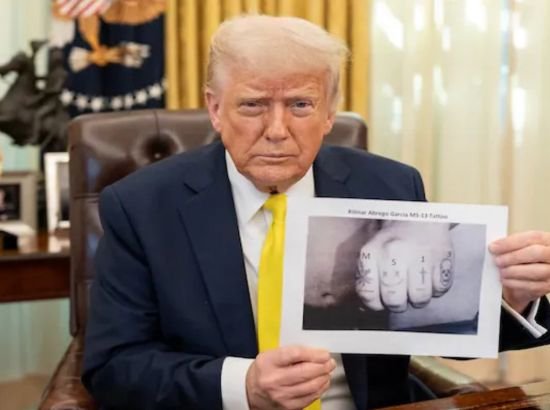
U.S. President Donald Trump shared a photograph on Friday evening, which he claimed showed the tattooed knuckles of Kilmar Abrego Garcia, a 29-year-old man who was deported to El Salvador last month amid controversy. Trump posted the image on his social media accounts, suggesting it as “proof” that Abrego Garcia was a member of the violent MS-13 gang.
However, the photo has come under scrutiny, with critics, including tech experts and political opponents, questioning its authenticity. Some have suggested that the image was digitally manipulated.
Abrego Garcia’s legal team argues that his deportation was unlawful. The image, showing a man’s knuckles with the “MS-13” tattooed above four small symbols, was accompanied by a post in which Trump criticized Democrats for allegedly defending “a fine and innocent person.” Trump insisted that Abrego Garcia was a violent gang member, despite the Democratic claims that he was not a member of MS-13.
Trump’s post stated: “This is the hand of the man that the Democrats feel should be brought back to the United States, because he is such a ‘fine and innocent person.’ They said he is not a member of MS-13, even though he’s got MS-13 tattooed onto his knuckles, and two highly respected courts found that he was a member of MS-13, beat up his wife, etc. I was elected to take bad people out of the United States, among other things. I must be allowed to do my job. MAKE AMERICA GREAT AGAIN!”
Almost immediately after Trump posted the image, it drew accusations of digital manipulation. Several social media users pointed out inconsistencies in lighting and the typography on the tattoo. One user commented that the “MS-13” text appeared as if it had been typed onto the photo, while others noted pixelation and misalignment of the letters, suggesting the photo had been altered.
Former Minnesota state senator Linda Higgins criticized Trump on X (formerly Twitter), writing: “Hey Old Man, @realDonaldTrump, have someone teach you about Photoshop. This is an excellent example of altering a photo, in this case to make your illegal actions look good.”
While Trump has insisted that the image proves Abrego Garcia’s gang membership, court documents filed by U.S. government attorneys do not mention tattoos as evidence in their case. U.S. Attorney General Pam Bondi recently released documents claiming that Abrego Garcia was known by the gang rank “Chequeo” and street name “Chele,” but the filings did not include any photographic or physical evidence to support the claim of gang affiliation.
Some social media investigators pointed to older images and videos of Abrego Garcia, posted by his wife on TikTok, showing tattoos on his knuckles but without the “MS-13” text.
Abrego Garcia arrived in the U.S. in 2011 as a 16-year-old, fleeing threats from Barrio 18 gang members who extorted his family’s small food shop in El Salvador. His family feared he would be recruited by criminal gangs. He worked in construction in Maryland and later became the primary provider for his family, which included two children with autism.
In 2019, Abrego Garcia was detained outside a Home Depot by an anti-gang unit, with a confidential informant claiming he had ties to MS-13. However, an immigration judge ruled that deporting him would put him at risk, allowing him to remain in the U.S. with a work permit.
This protection was overturned in March 2025, when Abrego Garcia was detained while shopping with his son and swiftly deported to El Salvador within three days, despite the standing court order.